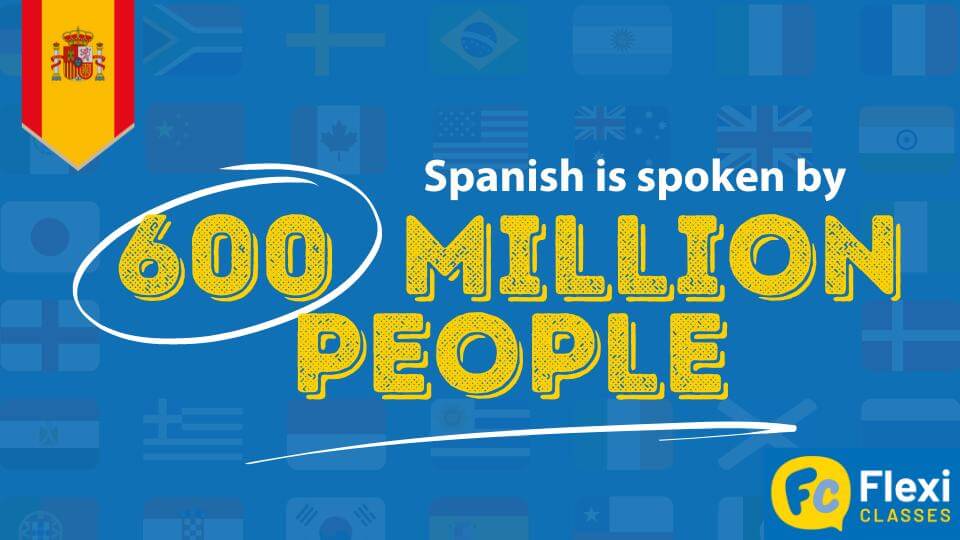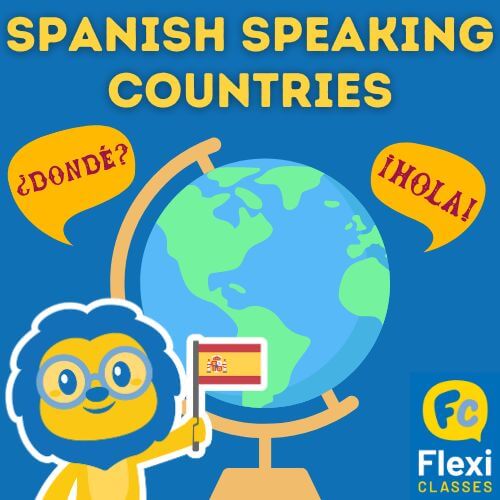🌎Spanish Speaking Countries - Together we Make 600 Million!
Learn about Spanish Speaking Countries PLUS Similarities and Differences Between Them
😮 WOW! According to studies done as recently as 2023, the Spanish language is spoken or being studied by close to 6️⃣0️⃣0️⃣ million people worldwide. These are the stats:

– close to 500 million speak Spanish fluently as native speakers;
– more than 76 million speak Spanish with limited competence; and
– close to 23 million are in the process of learning Spanish.
Pretty impressive, huh?

⚾ Ballpark figure: Spanish – as of 2023 – is being spoken by 7.44% of the world’s population, making Spanish the second most spoken language globally, outranking English and coming second only to Mandarin.
🇪🇸 Let’s breakdown the stats and see exactly where Spanish is spoken!
Spanish Speaking Countries || Español, the Spanish Unified Language
Spanish Speaking Countries || Spanish Speaking Countries
Spanish Speaking Countries || Notable Linguistical Differences in Different Spanish Speaking Countries
Spanish Speaking Countries || Quiz
Spanish Speaking Countries || FAQs
Spanish Speaking Countries ||
Español, the Spanish Unified Language
The terms español and castellano are both valid and synonymous when referring to the language spoken in Spain, in many American countries (Latin American and the USA) and in other parts of the world.

However, doubts about which term is more appropriate to refer to Spanish as a unified language, have long been resolved.
The term español is the recommended one when referring to the Spanish language, as it is all-encompassing and unambiguous.
Although in current-day Spanish, the term castellano (Castillian Spanish) is still synonymous with the term español, it can more aptly used to refer to:
– the Romance dialect born in the Kingdom of Castilla in the Middle Ages
– the Spanish dialect actually spoken in the region of Castilla, Spain, or…
– the common language of the Spanish state, together with its other co-official languages such as Catalán, Basque or Gallego.]

Have a Good Day in Spanish 👋 How to Part Ways
Everyday Parting Phrases in Spanish – The Best Ways to Say Goodbye Let’s get these farewell ducks in order so you can express yourself correctly and comfortably. In general, most ways of saying farewell in Spanish are practically interchangeable, good…
Spanish Speaking Countries || Spanish Speaking Countries
The outreach of the Spanish language worldwide is undeniable, as it is the official language in 21 countries, across 3 continents: Europe, South America and Africa.
📍 In Europe: Spain.
📍 In South America: Argentina, Bolivia, Colombia, Costa Rica, Cuba, Chile, Ecuador, Guatemala, Honduras, Mexico, Nicaragua, Panama, Paraguay, Peru, Puerto Rico, Dominican Republic, El Salvador, Uruguay and Venezuela.
📍 In Africa: Equatorial Guinea.
There is also a substantial Spanishspeaking population worldwide in many other countries that do not have Spanish as their official language, like within certain parts of the United States of America, the Philippines, Japan and Brazil, just to name a few.
Lastly, the international significance and outreach of Spanish as a language is underscored by the fact that it is one of the official languages of renowned institutions such as the United Nations, UNESCO, European Union and MERCOSUR (Southern Common Market).
And for the data enthusiasts, here is the Spanish population is broken down in figures, according to countries that have Spanish as their official language and those that have Spanish speaking population as their minor language. Enjoy! ✨
Spanish-speaking countries with Spanish as the official language:
| Population of Spanish speaking Countries (Spanish as the Official Language) | ||||
|---|---|---|---|---|
| Country | Population | Native Speakers (%) | Native Domain Group | Limited Competence Group |
| Mexico | 131,230,255 | 96.8 % | 127,030,887 | 4,199,368 |
| Colombia | 52,156,254 | 99.2 % | 51,739,004 | 417,250 |
| Spain | 47,615,034 | 91.4 % | 43,520,141 | 4,094,893 |
| Argentina | 46,654,581 | 98.1 % | 45,768,144 | 886,437 |
| Venezuela | 33,728,624 | 97.3 % | 32,817,951 | 910,673 |
| Peru | 33,725,844 | 86.6 % | 29,206,581 | 4,519,263 |
| Chile | 19,866,923 | 95.9 % | 19,052,379 | 814,544 |
| Guatemala | 17,602,431 | 78.3 % | 13,782,703 | 3,819,728 |
| Ecuador | 15,924,108 | 95.8 % | 15,255,295 | 668,813 |
| Bolivia | 12,169,501 | 83.0 % | 10,100,686 | 2,068,815 |
| Cuba | 11,194,445 | 99.8 % | 11,172,056 | 22,389 |
| Dominican Republic | 10,711,155 | 97.6 % | 10,454,087 | 257,068 |
| Honduras | 9,745,149 | 98.7 % | 9,618,462 | 126,687 |
| Paraguay | 7,554,796 | 68.2 % | 5,152,371 | 2,402,425 |
| Nicaragua | 7,046,308 | 97.1 % | 6,841,965 | 204,343 |
| El Salvador | 6,364,940 | 99.7 % | 6,345,845 | 19,095 |
| Costa Rica | 5,262,237 | 99.3 % | 5,225,401 | 36,836 |
| Panama | 4,468,089 | 91.9 % | 4,106,174 | 361,915 |
| Uruguay | 3,423,108 | 98.4 % | 3,368,338 | 54,770 |
| Puerto Rico | 3,263,584 | 99.0 % | 3,230,948 | 32,636 |
| Equatorial Guinea | 1,715,000 | 74.0 % | 1,269,100 | 445,900 |
| Total | 481,422,366 | 94.5 % | 455,058,518 | 26,363,848 |
Spanish-speaking population in countries where Spanish is a minor language (not an official language):
| Spanish Speaking Population in Countries where Spanish is NOT the Official Language | ||
|---|---|---|
| Country | Native Domain Group | Limited Competence Group |
| United States of America | 41,254,941 | 15,500,000 |
| EU- 27 | 1,267,000 | 25,906,000 |
| United Kingdom | 215,000 | 4,830,000 |
| Morocco | 6,586 | 1,664,823 |
| Canada | 600,795 | 293,000 |
| Brazil | 460,018 | 96,000 |
| Australia | 171,378 | 375,000 |
| Switzerland | 205,768 | 331,557 |
| Philippines | 4,471 | 461,689 |
| Algeria | 175,000 | 48,000 |
| Belize | 165,339 | 36,000 |
| Japan | 131,000 | 29,000 |
| Israel | 104,000 | 45,000 |
| Netherlands Antilles | 9,821 | 137,215 |
| Aruba | 17,229 | 84,369 |
| Trinidad and Tobago | 4,000 | 66,401 |
| Andorra | 30,414 | 35,226 |
| Guam and North Mariana Islands (USA) | 1,201 | 58,000 |
| Norway | 13,000 | 24,000 |
| New Zealand | 22,000 | |
| Occidental Sahara | 22,000 | |
| Virgin Islands (USA) | 16,788 | |
| Turkey | 1,000 | 15,000 |
| Jamaica | 8,000 | |
| China | 5,000 | |
| Russia | 3,000 | |
| India | 1,000 | |
| Total | 44,889,278 | 50,058,280 |
Spanish Speaking Countries ||
Notable Linguistical Differences in Different Spanish Speaking Countries
As the Spanish language evolves and grows in different countries, it is only normal that there be some notable linguistical differences, proper to each location. Here are some of the main examples of said differences:
Phonetical Differences that occur in different Spanish speaking countries, like for example yeísmo and seseo.
Yeísmo. A phonetical change in pronunciation referred to as yeísmo occurs when the letter y and the digraph ll are pronounced the same way, with the sound /y/.

Meaning, a phonological confusion between the letters y and ll takes place, such as in the following example:
Both the words cayó (past tense of “to fall”) / calló (past tense of “to keep quiet”) would be pronounced as /cayó/.
This phonetical alteration occurs in many areas of Spain (Madrid, south of Spain, Canarias and in Spanish America (Hispanoamérica).
📌 Note that, although a yeísmo is admitted phonetically, it is not considered correct in the written form.
Seseo. The phonetical change in pronunciation referred to as seseo occurs when there is confusion between the consonants c and z.
👉 So, phonetically ce, ci, za, zo and zu are pronounced as se, si, sa, so and su.
Have you noticed any linguistic differences between Spanish-speaking countries? Let us know in the comments section!
One of the main linguistical differences that occur between some Spanish American speaking countries – like Argentina, Paraguay, Uruguay and Central America – and the one spoken in Spain refers to the differences in word structure.

Some examples of these phonetical changes are:
cena (dinner), pronounced as sena
raza (race), pronounced as rasa
cisne (swan), pronounced as sisne
zumo (juice), pronounced as sumo
buzón (mailbox), pronounced as busón
📌 It is important to note that these alterations are admitted in the pronunciation but not in the written form.
The areas where the seseo will be most commonly heard are in Spanish America (Hispanoamérica) and within certain regions of Spain such as in Andalucía and the Canary Islands.
This is morphological alteration is known as the voseo phenomenon.
Voseo consists of the use of the pronoun vos (you instead of tú and ti (singular informal in the second person). The plural of vos would not be the regular vosotros used in Spain but instead would be ustedes. Here are some examples of use.
Singular informal in the second person:
| EXAMPLE | INFINITIVE FORM | VS | WHEN USED WITH ‘VOS’ |
| Are you coming to the dinner? | ¿Tú vienes a la cena? | ¿Vos venís a la cena? | |
| Do you want to see the soccer game? | [¿Tú quieres ver el partido de fútbol?] | ¿Vos querés ver el partido de fútbol? |
👆 In the examples above, note that when using the pronoun vos, used mainly in the present indicative, the verbs are changed by dropping the “r” from the infinitive form of the verb and then by adding an accent in the last syllable, followed by an ‘s’, like so:
– venir (to come) becomes venís (when used with vos)
– querer (to want) becomes querés (when used with vos)
Plural informal:
Ustedes bailan muy bien . vs Vosotros bailáis muy bien . (You all dance very well).
¿En qué calle viven Ustedes? vs ¿En qué calle vivís vosotros? (In what street do you all live?)
👉 See the following cheat chart for easy reference:
| INFORMAL | FORMAL | |||
| Singular | Plural | Singular | Plural | |
| Spanish | tú | vosotros | Usted | Ustedes |
| Spanish American | tú (or vos) | ustedes | Usted | Ustedes |
Spanish Speaking Countries || Quiz
Since you’ve learned all about Spanish Speaking Countries, why not check out these Spanish essentials?
👉 How to Say Nice to Meet You in Spanish
BONUS || If you enjoyed this article, find out How Many Countries Speak Chinese!
Spanish Speaking Countries || FAQs
What is the difference between español and castellano?
You will probably find many diverse and conflicting answers in this regard.
However, the correct answer is that both español and castellano synonymously translate to Spanish, referring to the language spoken in Spain, in many American countries (Latin American and the USA) and in other parts of the world.
There is a more appropriate term used to refer to Spanish (as a unified language) and that term is español, as it is all-encompassing and unambiguous. Moreover, it is the term used internationally to refer to the Spanish language, like in these examples:
Spanish, espagnol, Spanisch, spagnolo, etc.
The term castellano (Castillian Spanish), on the other hand, although in current day Spanish is still synonymous with the term español, is preferably used to distinctly refer to:
– the Romance dialect born in the Kingdom of Castilla in the Middle Ages;
– the Spanish dialect actually spoken in the region of Castilla, Spain: or
– the common language of the Spanish state, together with its other co-official languages such as Catalán, Basque or Gallego.
What is Spanish called in Latin America?
The Real Academia Española (the foremost authority in the Spanish language), in its lexicon, does distinguish between European Spanish (español europeo) and American Spanish (español americano).
Español europeo would mainly refer to the one spoken in Spain.
Español americano would mainly refer to the one spoken in both Latin American speaking countries and in the USA.
What country speaks the most Spanish?
Mexico, hands down is the country that has the most Spanish speaking population.
Now some raw data derived from 2023 census information:
Out of the total Mexican population of 131,230,255, it turns out that 96.8% are native Spanish speakers, which translates to 127,030,887 million. That’s almost three times as much as the native Spanish speakers of Spain itself, 43,520,141.
In which countries is Spanish an official language?
There are currently 21 countries, across three continents (Europe, South America and Africa), that have Spanish as their official language, these countries being:
In Europe: Spain.
In South America: Argentina, Bolivia, Colombia, Costa Rica, Cuba, Chile, Ecuador, Guatemala, Honduras, Mexico, Nicaragua, Panama, Paraguay, Peru, Puerto Rico, Dominican Republic, El Salvador, Uruguay and Venezuela,
In Africa: Equatorial Guinea.
Is Spanish an official language in the US?
While the 2021 US Census Bureau confirms that there are more than 41 million speakers in the US (including both Hispanics and those that are not but affirm to speak Spanish in their households), Spanish is not an official language in the US.
Interestingly enough though, it is estimated that by 2060, the US shall be considered the second largest country with a Spanish speaking population and that by then 27.5% of the US population will be of Hispanic origin.
So, who knows? Spanish might yet become the norm.
Want More From LTL?
FANCY LEARNING SPANISH? Check out our online Spanish courses here.
We offer a 7-day free trial to all online students where you can study Spanish 24/7. It doesn’t end there either.
We teach over 10 of the world’s most popular languages 😎
Come and be a part of our amazing community.










